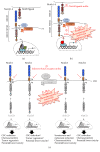Notch Signaling Activation as a Hallmark for Triple-Negative Breast Cancer Subtype
- PMID: 31379945
- PMCID: PMC6657611
- DOI: 10.1155/2019/8707053
Notch Signaling Activation as a Hallmark for Triple-Negative Breast Cancer Subtype
Abstract
Triple-negative breast cancer (TNBC) is a subgroup of 15%-20% of diagnosed breast cancer patients. It is generally considered to be the most difficult breast cancer subtype to deal with, due to the lack of estrogen receptor (ER), progesterone receptor (PR), and human epidermal growth factor receptor 2 (HER2), which usually direct targeted therapies. In this scenario, the current treatments of TNBC-affected patients rely on tumor excision and conventional chemotherapy. As a result, the prognosis is overall poor. Thus, the identification and characterization of targets for novel therapies are urgently required. The Notch signaling pathway has emerged to act in the pathogenesis and tumor progression of TNBCs. Firstly, Notch receptors are associated with the regulation of tumor-initiating cells (TICs) behavior, as well as with the aetiology of TNBCs. Secondly, there is a strong evidence that Notch pathway is a relevant player in mammary cancer stem cells maintenance and expansion. Finally, Notch receptors expression and activation strongly correlate with the aggressive clinicopathological and biological phenotypes of breast cancer (e.g., invasiveness and chemoresistance), which are relevant characteristics of TNBC subtype. The purpose of this up-to-date review is to provide a detailed overview of the specific role of all four Notch receptors (Notch1, Notch2, Notch3, and Notch4) in TNBCs, thus identifying the Notch signaling pathway deregulation/activation as a pathognomonic feature of this breast cancer subtype. Furthermore, this review will also discuss recent information associated with different therapeutic options related to the four Notch receptors, which may be useful to evaluate prognostic or predictive indicators as well as to develop new therapies aimed at improving the clinical outcome of TNBC patients.
Figures


Similar articles
-
The functional role of Notch signaling in triple-negative breast cancer.Vitam Horm. 2013;93:277-306. doi: 10.1016/B978-0-12-416673-8.00013-7. Vitam Horm. 2013. PMID: 23810012 Review.
-
Potential therapeutic targets of triple-negative breast cancer based on its intrinsic subtype.Oncotarget. 2017 Aug 16;8(42):73329-73344. doi: 10.18632/oncotarget.20274. eCollection 2017 Sep 22. Oncotarget. 2017. PMID: 29069872 Free PMC article. Review.
-
Clinical significance of Notch receptors in triple negative breast cancer.Breast Dis. 2023;42(1):85-100. doi: 10.3233/BD-220041. Breast Dis. 2023. PMID: 36970890
-
A targetable androgen receptor-positive breast cancer subtype hidden among the triple-negative cancers.Arch Pathol Lab Med. 2015 May;139(5):612-7. doi: 10.5858/arpa.2014-0122-RA. Epub 2014 Oct 13. Arch Pathol Lab Med. 2015. PMID: 25310144 Review.
-
Clinicopathological characteristics of triple negative breast cancer at a tertiary care hospital in India.Asian Pac J Cancer Prev. 2014;15(24):10577-83. doi: 10.7314/apjcp.2014.15.24.10577. Asian Pac J Cancer Prev. 2014. PMID: 25605142
Cited by
-
Impact of molecular subtypes on metastatic behavior and overall survival in patients with metastatic breast cancer: A single-center study combined with a large cohort study based on the Surveillance, Epidemiology and End Results database.Oncol Lett. 2020 Oct;20(4):87. doi: 10.3892/ol.2020.11948. Epub 2020 Aug 5. Oncol Lett. 2020. PMID: 32863920 Free PMC article.
-
The Role of Notch3 Signaling in Cancer Stemness and Chemoresistance: Molecular Mechanisms and Targeting Strategies.Front Mol Biosci. 2021 Jun 14;8:694141. doi: 10.3389/fmolb.2021.694141. eCollection 2021. Front Mol Biosci. 2021. PMID: 34195229 Free PMC article. Review.
-
Thioridazine hydrochloride: an antipsychotic agent that inhibits tumor growth and lung metastasis in triple-negative breast cancer via inducing G0/G1 arrest and apoptosis.Cell Cycle. 2020 Dec;19(24):3521-3533. doi: 10.1080/15384101.2020.1850969. Epub 2020 Dec 14. Cell Cycle. 2020. PMID: 33315498 Free PMC article.
-
Reciprocal inhibition of NOTCH and SOX2 shapes tumor cell plasticity and therapeutic escape in triple-negative breast cancer.EMBO Mol Med. 2024 Dec;16(12):3184-3217. doi: 10.1038/s44321-024-00161-8. Epub 2024 Oct 30. EMBO Mol Med. 2024. PMID: 39478150 Free PMC article.
-
Hydroxytyrosol, a Component of Olive Oil for Breast Cancer Prevention in Women at High Risk of Cancer.Int J Breast Cancer. 2025 Jan 21;2025:8831168. doi: 10.1155/ijbc/8831168. eCollection 2025. Int J Breast Cancer. 2025. PMID: 39882028 Free PMC article.
References
-
- Torre L. A., Siegel R. L., Ward E. M., Jemal A. Global cancer incidence and mortality rates and trends--an update. Cancer Epidemiology, Biomarkers & Prevention. 2016;25(1):16–27. - PubMed
-
- Carlson R. W., Allred D. C., Anderson B. O., Burstein H. J., Carter W. B., Edge S. B., et al. Breast cancer. Clinical practice guidelines in oncology. Journal of the National Comprehensive Cancer Network. 2009;7(2):122–192. - PubMed
Publication types
LinkOut - more resources
Full Text Sources
Research Materials
Miscellaneous

